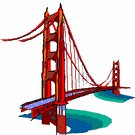
Worksheets and No Prep Teaching Resources
Reading Comprehension Worksheets
Forces and Motion

Forces and Motion
 Worksheets and No Prep Teaching Resources Reading Comprehension Worksheets Forces and Motion |
 Forces and Motion |
| edHelper's suggested reading level: | grades 4 to 5 | |
| Flesch-Kincaid grade level: | 5.94 |
|
Push + Pull = Bridge?
By Trista L. Pollard |

|
 1 You see them everywhere. When you travel on those long family vacations, you even cross a few of them. What are they? They are bridges. Bridges are structures that cross rivers and lakes. They have been around for thousands of years. What makes these structures special is how they are able to support their weight and the weight of vehicles traveling across their spans. So what helps bridges to stand over running water?
1 You see them everywhere. When you travel on those long family vacations, you even cross a few of them. What are they? They are bridges. Bridges are structures that cross rivers and lakes. They have been around for thousands of years. What makes these structures special is how they are able to support their weight and the weight of vehicles traveling across their spans. So what helps bridges to stand over running water? |
Create Weekly Reading Books
Prepare for an entire week at once! |
| Leave your feedback on Push + Pull = Bridge? (use this link if you found an error in the story) |
 |
Forces and Motion
|
 |
Science
|